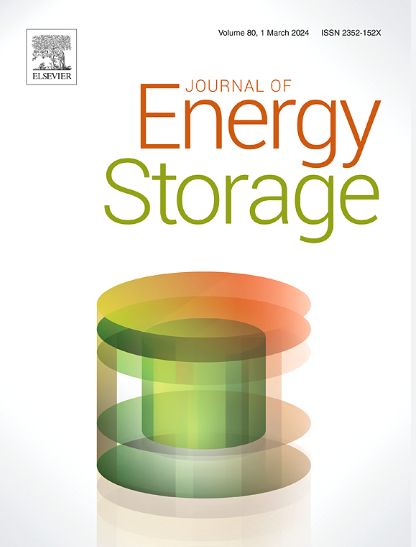Constructing a high ion conductivity artificial SEI on biomass derived hard carbon for sodium ion battery
IF 8.9
2区 工程技术
Q1 ENERGY & FUELS
引用次数: 0
Abstract
Constructing an artificial SEI on a hard carbon surface effectively enhances initial coulombic efficiency (ICE) and cycling stability. A polymer electrolyte binder containing sodium ions (SPEB), consisting of PAAS and PEO, is designed using a straightforward method. A high ion conductivity artificial SEI is constructed on a pomelo peel-derived hard carbon (PHC) surface through esterification and hydrogen bonding. In hard carbon anodes for sodium ion batteries (SIBs), SPEB plays a crucial role by facilitating pre-sodiation in PHC, enhancing ion conductivity, and guiding the construction of a NaF-rich, ultra-thin, and stable SEI. The synthesized PHC possesses an outstanding reversible specific capacity of 375.13 mAh·g−1, a superior ICE of 90.94 %, good rate capability, and excellent cycle stability. After 400 cycles at 0.9 A·g−1, it retains 152.52 mAh·g−1 with almost no decay. Meanwhile, SPEB demonstrates an exciting performance in other hard carbons and helps its commercialization application in SIBs.
基于生物质衍生硬碳制备高离子导电性人工SEI用于钠离子电池
在硬质碳表面构建人工SEI可以有效地提高初始库仑效率(ICE)和循环稳定性。设计了一种由PAAS和PEO组成的含钠离子聚合物电解质粘结剂(SPEB)。在柚子皮衍生的硬碳(PHC)表面通过酯化反应和氢键形成了高离子导电性的人工SEI。在钠离子电池(SIBs)的硬碳阳极中,SPEB通过促进PHC的预钠化,增强离子电导率,指导构建富naf、超薄、稳定的SEI起着至关重要的作用。合成的PHC具有375.13 mAh·g−1的可逆比容量、90.94%的高效能、良好的倍率性能和良好的循环稳定性。在0.9 A·g−1下循环400次后,它保持152.52 mAh·g−1,几乎没有衰减。同时,SPEB在其他硬碳中也表现出令人兴奋的性能,有助于其在sib中的商业化应用。
本文章由计算机程序翻译,如有差异,请以英文原文为准。
求助全文
约1分钟内获得全文
求助全文
来源期刊

Journal of energy storage
Energy-Renewable Energy, Sustainability and the Environment
CiteScore
11.80
自引率
24.50%
发文量
2262
审稿时长
69 days
期刊介绍:
Journal of energy storage focusses on all aspects of energy storage, in particular systems integration, electric grid integration, modelling and analysis, novel energy storage technologies, sizing and management strategies, business models for operation of storage systems and energy storage developments worldwide.
 求助内容:
求助内容: 应助结果提醒方式:
应助结果提醒方式:


